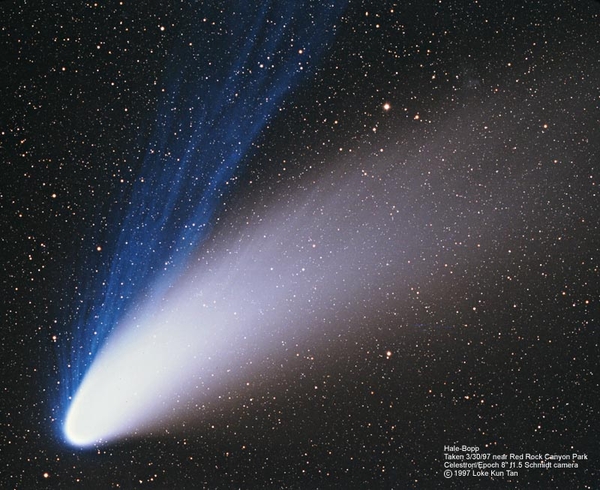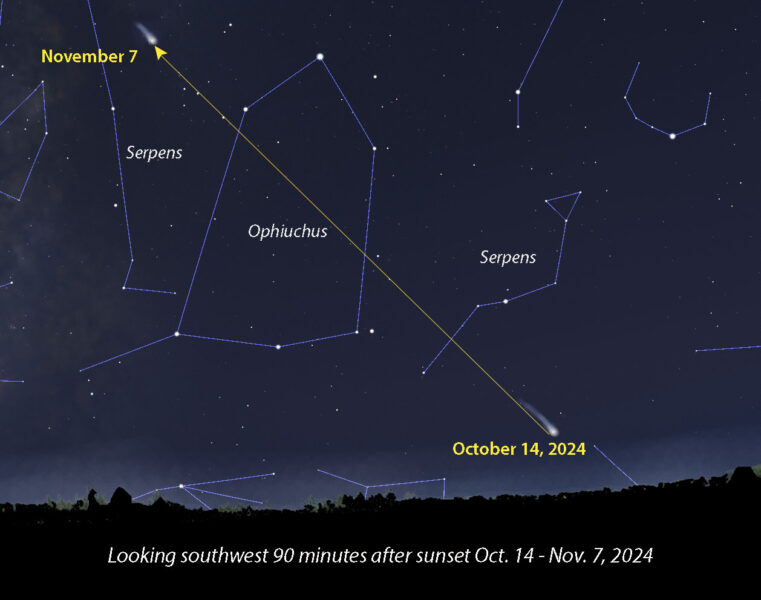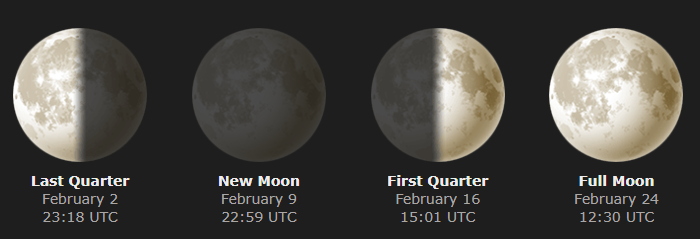What is a comet?
 A comet is an object which is made up of rock, dust, water ice, and frozen gases that orbit the Sun. They are incredibly old objects that are essentially made up of the material left over following the formation of our solar system, 4.5 billion years ago. Comets are famous for their distinctive tails (note, there is more than one tail to a comet) which are created as the comet is heated as it approaches the Sun.
A comet is an object which is made up of rock, dust, water ice, and frozen gases that orbit the Sun. They are incredibly old objects that are essentially made up of the material left over following the formation of our solar system, 4.5 billion years ago. Comets are famous for their distinctive tails (note, there is more than one tail to a comet) which are created as the comet is heated as it approaches the Sun.Comets originate from two distinct areas of our solar system, either the Kuiper belt or the Oort Cloud. Comets that come from the Kuiper Belt, a wide disc-like area of space beyond the orbit of Neptune, are called Short-period or periodic comets. Comets that come from the Oort Cloud, the sphere-like collection of rocks and ice that form the edge of the solar system, are called long-period comets as they take much longer to complete an orbit of the Sun, as they start their orbits 50 times further away than those from the Kuiper Belt.
Comets and their tails
Comets are famous because of their propensity to form spectacular tails as they approach the Sun. Whilst all comets will have a tail, not all tails are visible to the same extent. This is because each comet has a unique make-up, with different quantities of rock to ice, and different types of ice. Also, a comet’s orbit will determine the luminosity it will have, with some “sun-grazing” comets coming within touching distance of the star, to others having their closest approach being much further away.
Comets also have two tails, as shown clearly in this image of comet Hale-Bopp from its incredible appearance in 1997. The second, bluer, less dense tail is the comet’s ion tail. A comet’s ion tail is caused because of ultraviolet radiation from the Sun interacting with electrons in the comet's coma. This forms a plasma that streams directly away from the comet in the direction of the solar wind.
The stream of dust and rock from a comet’s dust tail is what creates some of the famous meteor showers we see here on Earth, including the Perseids which originate from comet Swift-Tuttle, and the Orionids which originate from comet Halley.
How best to observe comets
Whilst some comets are quite large, the distances involved in their orbits mean that direct observation with the naked eye is only possible once the comet is approaching the Sun at or about the distance of the orbit of the Earth. For the rest of their journey comets are tiny objects visible only by very large telescopes.
The first thing to do is to determine if/when any comets are expected to brighten as they approach the Sun. The best way to do this is via a quick check on the internet. This will also give you an idea of where and when to look.
Once you have a date/target make sure you head out to a dark sky location with an unobstructed view of the horizon. You should also take some binoculars with you, or a small telescope. Remember to give your eyes time to adjust to the dark.
If you are trying to observe with the naked eye, you might benefit from using a technique called averted vision. This is where you don’t look directly at the object, but rather about 10 to 20 degrees off to the side. This has the effect of allowing the light from distant, fuzzy objects like comets to bounce off more of the rods and cones inside your eye, making fainter objects easier to see. You can try this technique too with the Andromeda Galaxy (more on this next month).
What to expect in 2024
There have been many famous comets over the years, but will 2024 produce any worth mentioning? Possibly, there are a couple of expected comets that have the potential to become naked-eye objects this year.
12P/Pons-Brooks:
A short-period comet from the Kuiper belt, this comet has been found in ancient observations dating back to 1385 by the Chinese and early European observers. Its orbit is approximately 71 years in length with its aphelion being just beyond the orbit of Neptune.
This comet has a history of bright, naked-eye approaches to Earth including previous observations in 1884 and its last approach in 1954. This year the comet will pass from the constellation of Andromeda, through Pisces, and into Aries during the early evening in April. It is possible that it could brighten to become a naked-eye comet.
C/2023 A3 Tsuchinshan-ATLAS:
This comet from the Oort cloud was discovered by the Purple Mountain Observatory on 9 January 2023 and ATLAS South Africa on 22 February 2023. Its perihelion (closest approach to the Sun) will be on 27 September 2024 and will be visible in the Northern Hemisphere as an evening object in October. C/2023 A3 has the potential to become a naked-eye object. The following image shows the path of C/2023 A3 Tsuchinshan-ATLAS later this year. If it reaches naked eye brightness, it could be spectacular.

Comets in Sci-fi and Star Trek
Comets have been associated with doom and disaster by humans throughout recorded history, and recent depictions in modern sci-fi haven’t changed that. Whether it is Comet Wolf-Biederman from the 1998 film “Deep Impact”, or the unnamed comet in the 2021 film “Don’t Look Up”, comets are rarely shown as anything other than planet killers or omens of dark times.
- Tucker, on Archer's Comet
- Trakor’s Third Prophecy.
Finally, one of the most famous comets to be included in the series can be seen in the opening visuals of every Deep Space 9 episode. Set against the background of stars, with the rousing theme music written by American composer Denis McCarthy, the highly reflective, ice-bound comet streaks across the opening frame, with a large tail of dust and ice particles streaming behind.
The Moon
Here are the Moon’s phases during February, along with the dates.
• Last Quarter – 2nd February 2024
• New Moon – 9th February 2024
• First Quarter – 16th February 2024
• Full Moon – 24th February 2024

As the snowiest month in the United States, February’s full moon is commonly known as the Full Snow Moon in Native American cultures. These ancient tribes named this moon after the way trees cracked in the cold, or how people had to sit shoulder to shoulder around the fire for warmth. Even the Celts called it the Moon of Ice. As expected of the coldest month in the year, the Full Snow Moon is also known by more sinister names, such as the Bone Moon.
Thanks to MoonGiant for this information, read more about the February moon phases on their website.
Mercury
Mercury is now too close to the Sun to be easily visible from Earth, although it will form a super conjunction with Earth (when a planet is directly in line with us but from the opposite side of the Sun) on February 28th.
Venus
Venus is still a morning star (just). On the morning of Feb. 7, about an hour before sunrise, look very low above the southeast horizon, bright Venus will be to the right of the crescent Moon.
Mars
Whilst Mars is back from its trip behind the Sun, it is still a very dim little planet this month, caught in the early sunrise glare. It will continue to be near impossible to see with the naked eye until much later this month and into March. I’d advise giving Mars a miss this month.
Jupiter
Jupiter is visible throughout the month, although will be setting noticeably earlier as the month nears its end. If you are out with that special someone star gazing on Valentine's Day, look to the Southwest at dusk, you will see a waxing crescent moon accompanied by a very bright Jupiter just to the upper left.
Saturn
Saturn is finally beginning its transition out of the evening sky. Whilst it will be visible for the first couple of weeks of the month, it will finally be drowned out by the glare of Sunset and will be impossible to observe by the month’s end.
Uranus
Uranus can be found in Aries, but at a dim Magnitude 5.8, you will likely need binoculars or a small telescope to see much of anything. But it is visible until around midnight for the whole of the month.
Neptune
Neptune is visible (only with good binoculars or a good telescope) in Pisces, for around an hour after twilight, but will become invisible entirely by the end of the month.
Next Month’s Preview
Next month, I will look at the brightest naked-eye galaxy in the night sky - M31 or the Andromeda Galaxy and how to find it with a simple thumbs up.
What did you think of this edition of UFP Stellar Cartography? Let us know in the comments below.
WRITTEN BY WoorLord
EDITED BY WoorLord
IMAGES SOURCED FROM (NASA) Loke Kun Tan -Stellarium - MoonGiant.com


